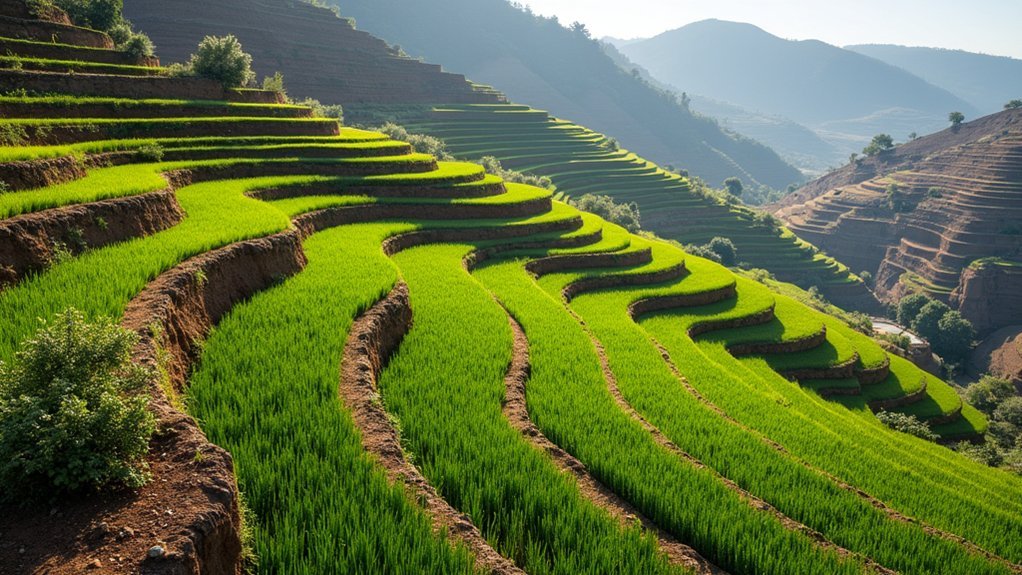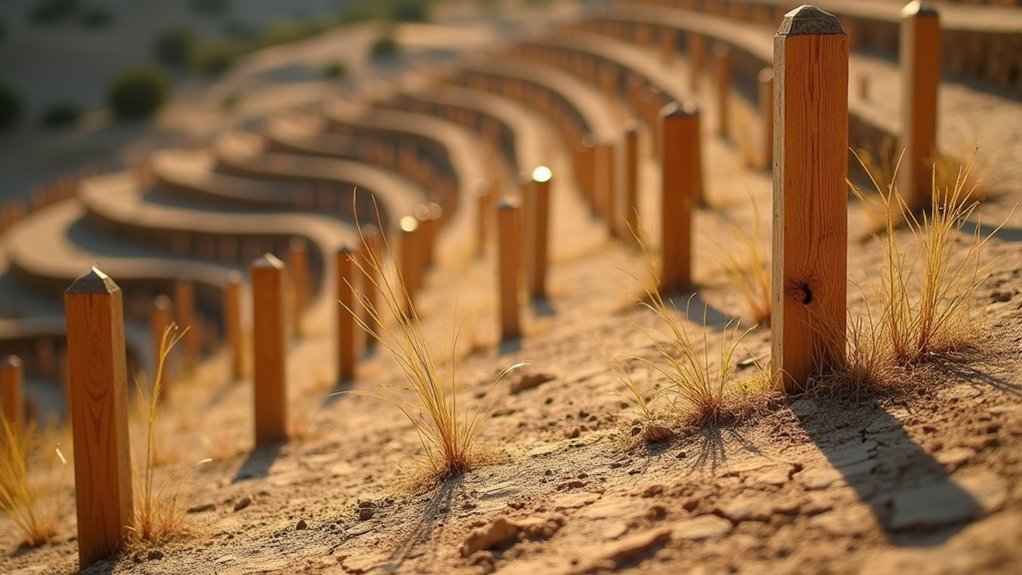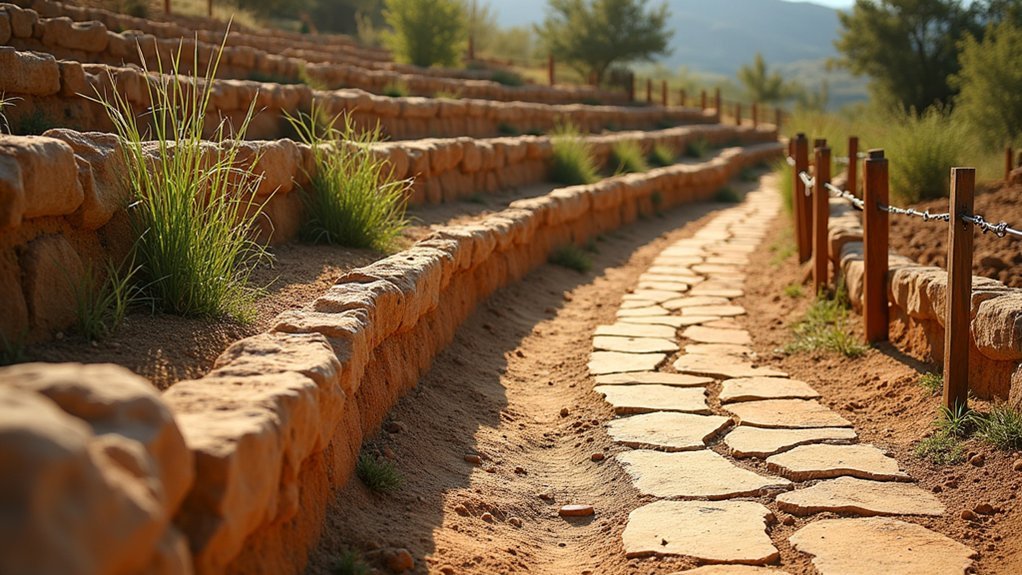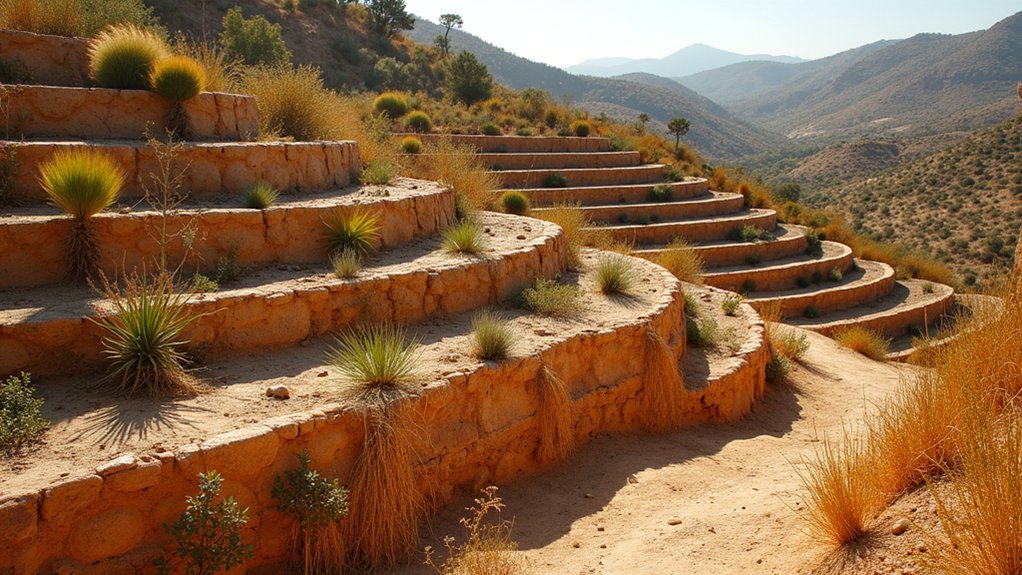Terraced fences survive drought through strategic water management systems that reduce erosion and improve moisture retention. You’ll need proper post installation (24-36 inches deep), drought-resistant materials like cedar or composite, and effective drainage channels. Incorporate native, drought-tolerant plants with varying root depths to stabilize soil and conserve water. Regular maintenance—clearing debris from channels and checking post stability—extends system lifespan. These combined strategies create resilient structures that withstand even the harshest dry conditions.
The Science Behind Terrace Structure and Drought Tolerance

While most conventional landscapes struggle during water shortages, terraced structures offer a remarkably effective solution for drought management. When you implement terraced designs, you’re creating a sophisticated water management system that works with nature rather than against it.
Terraced structures greatly reduce soil erosion by slowing water runoff, giving moisture more time to penetrate deeply into the soil. This enhanced infiltration guarantees your plants can access water even during drought conditions.
The engineering behind terraces also allows them to collect and redirect drainage water underground, supporting deep-rooted plants that naturally withstand dry periods.
You’ll find that properly built terraces can handle major storms without failure, maintaining their moisture conservation capabilities throughout extended drought conditions while preserving precious soil moisture and improving plant resilience.
Strategic Grounding Techniques for Dry Climates
When establishing fence grounding in arid regions, you’ll need to dig beyond the frost line to access consistently moist soil for effective electrical conductivity.
You should install proper drainage systems to direct any rainfall toward your ground rods, greatly improving their performance during drought conditions.
Incorporate native soil around your grounding points rather than imported materials, as local soil typically provides better long-term adaptability to regional moisture fluctuations.
Depth Beyond Frost Line
Because drought conditions can severely impact fence stability, installing posts beyond the frost line becomes essential rather than optional. Your fence post depth should reach 24 to 36 inches in dry climates, notably deeper than what’s needed for a temporary fence. This extra depth prevents heaving as soil moisture fluctuates and maintains structural integrity when Natural Resources like groundwater diminish during prolonged dry spells.
During drought, soil contracts and can loosen posts that aren’t set deeply enough. By anchoring posts well below the frost line, you’re creating a foundation that withstands these challenging conditions.
Regular inspections are vital – check for any post movement or tilting, especially after extreme temperature changes. When posts remain firmly planted at proper depths, your fence will continue functioning effectively despite the harsh drought environment.
Proper Drainage Installation
Beyond post depth considerations, your terraced fence system needs strategic drainage solutions to thrive in drought-prone areas. Proper drainage installation prevents structural damage and erosion that can undermine your fence’s stability during rare but intense rainfall events.
| Drainage Technique | Benefits | Maintenance |
|---|---|---|
| Sloped Terraces | Directs water away naturally | Check slopes annually |
| Permeable Geotextiles | Allows moisture flow without pooling | Replace when deteriorated |
| Gravel-Filled Drainage Channels | Prevents sediment buildup | Clear debris quarterly |
Regularly inspect your drainage channels for clogs that can hinder water flow. Install multiple ground rods spaced 10 feet apart for electric fencing to guarantee effectiveness even in dry soil conditions. This strategic approach to drainage will considerably extend your terraced fence’s lifespan by preventing water accumulation that leads to erosion and structural weakening.
Native Soil Utilization
Despite drought challenges, your terraced fence system’s performance hinges on effective ground connections with native soil. Proper grounding guarantees your fence remains functional even when rainfall is scarce.
To maximize native soil conductivity for peak grounding:
- Install ground rods at a ratio of three feet per joule of charger output—a six-joule system requires 18 feet of total rod length.
- Space multiple ground rods at least 10 feet apart to reach deeper, moisture-retaining soil layers.
- Apply water regularly around ground rods using a slow-drip bucket system to maintain moist soil conditions.
- Conduct monthly inspections of your grounding system, checking both rod conditions and soil moisture levels.
These techniques guarantee your terraced fence maintains electrical integrity through drought periods, preventing livestock escapes and maintaining your investment’s effectiveness.
Moisture-Retaining Materials for Terraced Fencing
When building terraced fences for drought-prone regions, you’ll want to select naturally resistant woods like cedar or redwood that withstand dry conditions without cracking.
Apply moisture-locking coatings such as silicone-based sealants or specialized polymer treatments to preserve your fence’s integrity during extended dry spells.
Integrating smart watering systems with moisture sensors near your terraced fencing can deliver precise hydration exactly when needed, conserving water while maintaining ideal moisture levels.
Drought-Resistant Wood Choices
Although drought conditions pose significant challenges for outdoor structures, selecting the right moisture-retaining materials for your terraced fencing can dramatically improve durability and performance.
When choosing drought-resistant woods for your terraced fencing project, consider these superior options:
- Cedar and redwood contain natural oils that resist moisture loss, preventing warping and cracking during dry spells.
- Cypress offers excellent resistance to rot and insect damage, maintaining its integrity through drought cycles.
- Treated lumber with chemical preservation extends fence life by protecting against decay that accelerates in drought conditions.
- Composite materials combining recycled wood fibers and plastic provide stability without the susceptibility to drying that affects traditional woods.
Don’t forget that proper sealing with water-repellent stains creates an additional protective barrier against moisture evaporation.
Moisture-Locking Fence Coatings
Beyond selecting the right wood type, applying specialized moisture-locking coatings to your terraced fence can dramatically enhance its drought resilience. These innovative coatings incorporate hydrogels and polymers that actively retain water, gradually releasing it to maintain soil moisture during drought conditions.
| Coating Type | Moisture Retention | Emotional Benefit |
|---|---|---|
| Hydrogel-infused | Exceptional | Relief during heat waves |
| Polymer-based | Very high | Peace of mind in dry seasons |
| Natural oil blend | Moderate | Connection to sustainable practices |
| Silicone-enhanced | High | Confidence in long-term protection |
| Hybrid formula | Maximum | Pride in advanced property care |
You’ll need to reapply these coatings periodically, especially in drought-prone areas. The investment pays off through improved plant growth near your fence, reduced soil erosion, and enhanced structural integrity that will help your terraced fencing withstand even prolonged dry spells.
Smart Watering Integration Systems
Innovative moisture-retaining materials take terraced fence protection to the next level, combining with smart watering systems for thorough drought management.
You’ll find these technologies work together to maintain ideal hydration while conserving valuable water resources.
- Integrate hydrogels or water-retaining polymers into your soil mixture to greatly boost moisture retention capacity, keeping your terraced plants hydrated during extended dry periods.
- Install drip irrigation systems that deliver water directly to plant roots, eliminating waste while ensuring targeted hydration.
- Add moisture sensors to monitor soil conditions in real-time, allowing your smart watering integration systems to activate only when necessary.
- Apply mulch alongside moisture-retaining materials to further reduce evaporation and suppress competing weeds that might steal precious water from your plants.
Microclimates Created by Terraced Designs
When properly constructed on sloped terrain, terraced fences transform harsh landscapes into havens of ecological diversity by creating distinct microclimates.
These structures considerably reduce wind exposure while enhancing moisture retention in the soil—critical factors during drought periods.
You’ll notice how terraces slow water runoff, giving moisture more time to penetrate deeply into the soil profile. This improved infiltration sustains vegetation even when rainfall is scarce.
The varying elevations you create with terracing foster specialized habitats where drought-resistant species can thrive according to their specific needs.
For best results, incorporate natural stone walls into your terrace design.
These elements add thermal mass that moderates soil temperature and preserves moisture levels.
Proper Spacing and Post Alignment for Water Efficiency

Your post placement strategy on terraced land directly impacts how water moves through your property during both wet and dry periods.
You’ll need to space posts every 2-3 meters and align them vertically, with double posts for significant drops around 3 meters, to prevent disrupting natural water flow patterns.
Regular checks after heavy rainfall will guarantee your water-shedding fence design continues to promote efficient drainage while preserving precious soil moisture during drought conditions.
Post Placement Strategies
Strategic post placement forms the backbone of drought-resistant terraced fencing systems. When installing your fence along sloped terrain, you’ll need to position posts every 2-3 meters, adjusting spacing according to the slope’s angle. Proper post placement enhances stability while maintaining ideal soil moisture levels throughout dry periods.
Always align posts vertically with the slope’s contour to prevent water pooling that leads to erosion. Dig footings at least 60cm deep to counter soil contraction during drought conditions.
For maximum drought resilience, follow these key practices:
- Install brace bars every 25 meters for structural integrity
- Check post alignment regularly for early signs of shifting
- Confirm vertical alignment follows natural contours
- Maintain consistent post depth across the terrace system
Water-Shedding Fence Designs
Water-shedding fence designs complement effective post placement by maximizing drainage capabilities during both dry spells and sudden downpours.
When you’re planning your terrace fencing, proper spacing between posts and boards creates pathways for runoff to flow naturally, preventing harmful pooling that depletes precious soil moisture.
Align your posts vertically and anchor them deeply to maintain structural integrity through drought-rain cycles. Incorporate a slight gradient in your design to channel water away from post bases, reducing erosion risk.
Choose permeable materials that promote water infiltration, enhancing moisture retention in your terraced soil.
Don’t neglect regular maintenance checks. Drought causes soil contraction that can shift your carefully designed system.
Realigning posts and adjusting spacing as needed guarantees your water-shedding features continue functioning effectively, protecting your investment through unpredictable weather patterns.
Weather-Resistant Plant Selection for Living Barriers
While creating terraced fences during drought conditions presents challenges, choosing appropriate weather-resistant plants can transform these barriers into sustainable, low-maintenance assets.
You’ll find that native species adapted to local conditions require minimal intervention while providing excellent stability.
For ideal drought resistance in your living barriers, consider:
- Succulents like agave and sedum that store water and thrive in dry conditions
- Drought-resistant grasses such as blue fescue and switchgrass that develop deep root systems
- Plants with varying root depths to improve soil stability and moisture retention
- Species with similar water requirements grouped together to maximize irrigation efficiency
Water Management Systems in Terraced Landscapes

Beyond plant selection, effective water management systems form the backbone of successful terraced landscapes during drought conditions.
While plants matter, it’s thoughtful water management that truly sustains terraced landscapes when drought strikes.
You’ll find that properly designed terraces considerably slow water runoff, allowing better soil moisture retention when rainfall is scarce.
The construction includes underground drainage features that direct water into the soil profile, maintaining moisture levels even during extended dry periods.
When you space terraces strategically, you’ll maximize erosion conservation while optimizing water preservation, particularly beneficial in arid regions.
Don’t overlook maintenance—regular clearing of terrace channels prevents sediment buildup that could compromise their effectiveness.
Consider adding buffer strips around your terraced landscape to filter sediment before it enters tile lines, further enhancing your water management system’s efficiency during drought conditions.
Soil Compaction and Drought Resistance Correlation
Although often overlooked, soil compaction plays an essential role in determining how terraced landscapes respond to drought conditions.
When you’re managing terraced lands, understanding this relationship can greatly improve drought resistance.
Compacted soil restricts water infiltration and root development, increasing drought vulnerability.
To enhance your terraced landscape’s resilience:
- Maintain regular soil aeration to improve structure and water absorption
- Minimize heavy machinery use on terraced areas to prevent compaction
- Implement controlled grazing practices to protect soil integrity
- Utilize the level surfaces terraces provide to maximize moisture retention
Maintenance Practices During Extended Dry Periods

Just as soil compaction affects drought resilience, proper maintenance of terraced fences becomes even more important during extended dry periods.
You’ll need to regularly inspect your fence posts for stability, as drought causes soil to contract, creating gaps that compromise structural integrity.
Don’t overlook terrace channels—clear sediment deposits to guarantee proper drainage, preventing erosion that can damage your entire system.
Monitor soil moisture levels around ground rods for electric fencing, as dry conditions reduce conductivity and weaken effectiveness.
Rehabilitate low spots in terrace ridges by adding soil and reestablishing grass coverage.
For ideal results, consult local conservation services about maintenance practices specifically designed for drought conditions.
These proactive steps will help your terraced fence system remain resilient and effective despite prolonged dry spells.
Adapting Traditional Terrace Methods for Modern Fencing
While ancient terracing techniques have proven effective for centuries, today’s property owners can seamlessly blend these time-tested methods with contemporary fencing materials and designs.
State University researchers found that traditional dry stone walls greatly enhance fence durability during drought conditions.
Traditional dry stone walls significantly improve fence longevity when facing prolonged drought challenges.
You can modernize terraced fencing by:
- Utilizing double post solutions for high steps, providing essential support against soil shifting
- Implementing proper spacing (every 25 meters with brace bars) to counter dry soil contraction
- Incorporating decorative screening elements that provide shade and reduce soil temperature
- Sourcing local materials that guarantee environmental compatibility and drought resistance
For additional resources on drought-resistant terracing techniques, contact the Sustainable Landscaping Department (your email address will be protected by reCAPTCHA when submitting inquiries through their portal).
Case Studies: Successful Drought-Surviving Terraced Barriers

Despite facing severe water shortages, several communities have implemented remarkably resilient terraced fence systems that continue to thrive in arid conditions. You’ll find their success stems from combining traditional wisdom with modern techniques.
| Location | Key Success Factors |
|---|---|
| Arizona | Dry stone walls + native cacti plantings |
| Southern Spain | Strategic runoff channels + maintenance schedule |
| Australia | Indigenous plant selection + microclimate creation |
| East Africa | Sediment monitoring + integrated stone terracing |
These case studies demonstrate how proper drainage integration prevents soil erosion while capturing precious moisture. When you incorporate drought-resistant native plants alongside your terraced barriers, you’ll reduce irrigation needs while maintaining soil health. Regular maintenance, particularly clearing drainage channels and monitoring sediment accumulation, has proven essential for long-term effectiveness during extended dry periods.
Frequently Asked Questions
How Does Terracing Prevent Water Loss?
Terracing prevents water loss by slowing runoff on slopes, allowing more water to infiltrate your soil. You’ll see less erosion as terraces capture rainfall, directing it underground where it’s stored for your crops during dry periods.
How Does Terracing Preserve Soil?
Terracing preserves soil by reducing erosion on sloped fields. You’ll find that terraces break up the slope, slowing water runoff and preventing topsoil from washing away during rainfall, maintaining your land’s fertility.
What Is the Main Problem With Terrace Farming?
The main problem with terrace farming is that you’ll face significant maintenance challenges. If you don’t properly maintain the terraces, they’ll cause soil erosion, water management issues, and uneven moisture distribution during droughts.
What Crops Is Terracing Most Successful With?
Terracing is most successful with deep-rooted crops like potatoes and carrots, grains such as corn and wheat, legumes including beans and peas, and fruits like grapes and olives. You’ll also see great results with native grasses.
In Summary
You’ve seen how terraced fences survive drought through strategic design, proper materials, and thoughtful installation. By creating microclimates, managing soil compaction, and maintaining appropriate post spacing, you’ll maximize water efficiency. Don’t forget that regular maintenance during dry periods is essential. When you adapt traditional terracing principles to your modern fence, you’re building a structure that won’t just withstand drought—it’ll thrive despite it.





Leave a Reply